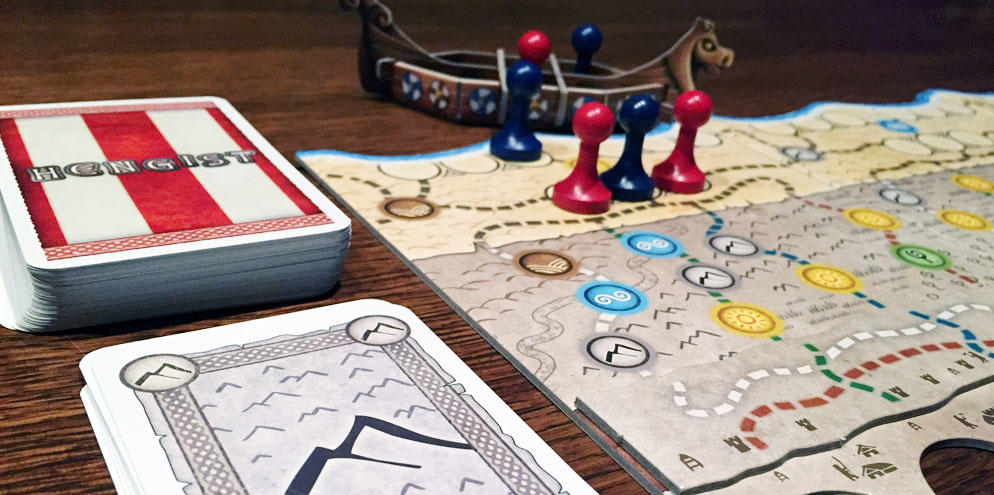
 When you have designed as many games as Uwe Rosenberg has, there is a certain amount of excitement that follows every game he releases. You might be familiar with some of Uwe’s work: Agricola, Caverna, and Fields of Arle. Recently, he as made headlines with his fantastic two player game Patchwork, where he somehow made a game about quilting pretty darn enjoyable.
When you have designed as many games as Uwe Rosenberg has, there is a certain amount of excitement that follows every game he releases. You might be familiar with some of Uwe’s work: Agricola, Caverna, and Fields of Arle. Recently, he as made headlines with his fantastic two player game Patchwork, where he somehow made a game about quilting pretty darn enjoyable.
Uwe has once again dipped his toes in the 2 player only waters with his newest offering, Hengist. Instead of collecting buttons and patches, this time players take on the role of two Saxon brothers pillaging the English coast for treasure and plunder. Did he give us the next great offering in his 2 player line? Time to find out!
Hengist is a two player card game of exploration and hand management that takes about 20 minutes to play.
Game Overview:
In Hengist, players are trying to accumulate the most treasure over the course of the game. Each turn, a player can take an action with each of their three raiding groups. This usually involves moving around the board into positions to raid villages. However, the most direct paths to the best treasure will be obscured, so the obvious path might actually lead to the worst treasure. Through experimentation and the use of spies, players can find the path to the best treasure and increase their wealth.
The game ends once the keel boat moves off the board for the fourth time. At that point, players count up their treasure and the richest Saxon is the winner!
Game Components:
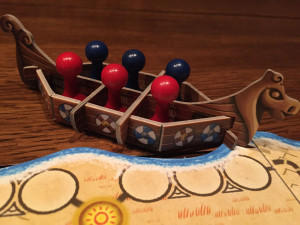
I don’t have much in the way of complaints with the components in Hengist. My favorite part of the game has to be the 3D keel boat. Once assembled, it has slots for each of the 6 raiding party pawns. The pawns themselves are somewhat uninspired, especially compared to the quality of the other components. They are about as generic as it gets.
Moving on, the game comes with 60 different cards to be used for moving around the game board and raiding. The cards come in a few different colors, including some cards that have split colors. The game board itself comes in three, dual sided pieces. The board is filled with a series of paths, each of which notes which color card(s) must be played to move your raiding party across it.
Finally, in addition to the 30 treasure tokens, the game comes with 12 road tiles. These are used for the raiding mechanic, which we’ll get to in a minute. Overall, players can be happy with the quality of the components.
How to Play:
The rules for Hengist are fairly simple. Each player starts with 3 raiding parties and 3 cards. The game boards are placed side by side and a road token is played face down in the appropriate spot on each board. Finally, 4 treasure tokens are placed in descending order in the spots at the bottom of each board.
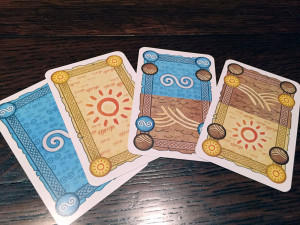
On their turn each player may take one action with each of their three raiding groups. The different actions you can take are:
• Move a group into or out of the boat (No cost)
• Move a raiding group along a road: This will usually move a group from the beach to the hinterlands (or back) or to the hinterlands on an adjacent board. This will cost one card of the color marked on the road.
• Raid a Village
This is where the main part of the game happens. Each raiding path requires 2-3 cards of a specific color. However, the bottom of the path is obscured by the road tile. The roads on this tile are not always direct to the bottom, so some paths may lead to unexpected places. Once a player chooses a path and plays their cards, look at the other side of the road tile to see where their path ends up.
In addition to the six different colored cards, there are a handful of black cards. Black cards can be used in up to 3 different ways:
- As a wild terrain card
- As a spy to look at a hidden road tile
- As a reinforcement card to gain back a lost raiding group.
Each time a black card is played, the keel boat moves one spot to the right. Once it moves off the edge of the 3rd board, the leftmost board is flipped over and setup to the right of the keel boat. Any raiding parties that were on the flipped board are lost (they may be brought back with the reinforcement card).
At the end of a players turn, they draw 2 cards, plus one extra card for each raiding party in the Hinterlands.
The game continues in this manner until the keel boat has driven off the board three times. At that point, players count up their treasure and the player with the most is the winner.
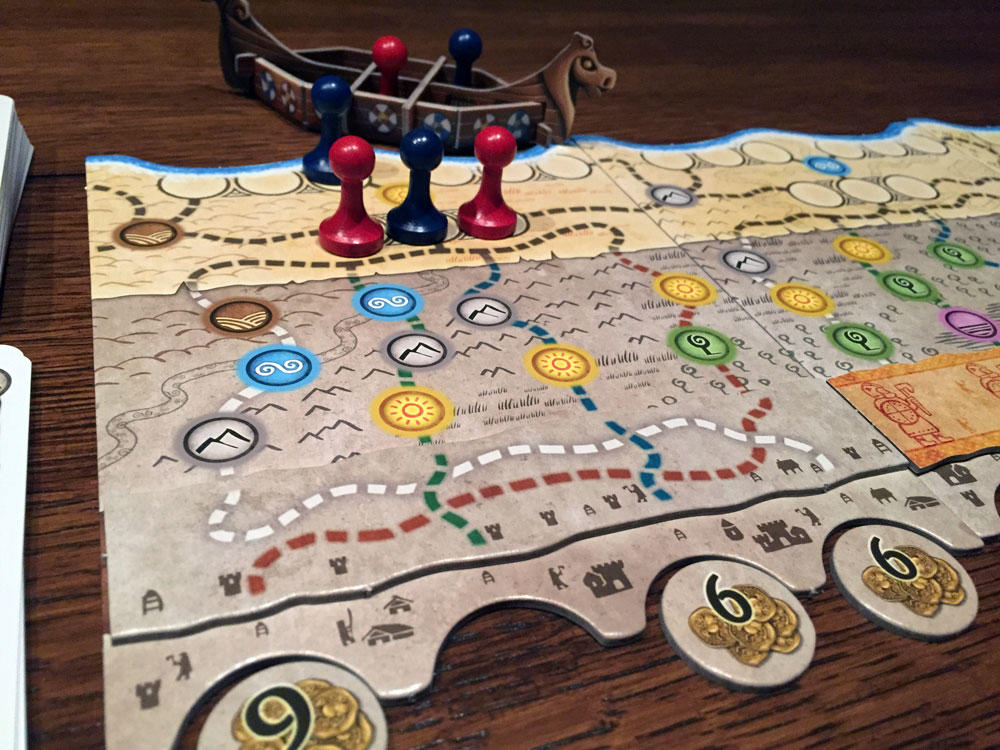
Game Experience:
There are a handful of game designers that you can put on a box and immediately get people’s attention. Eric Lang, Antonine Bauza, Vlaada Chvatil, to name a few. I’d say that Uwe Rosenberg definitely would be in that group. So it was with no shortage of excitement that we dove into Hengist, especially considering how much we enjoyed Patchwork.
After putting ourselves through a few plays of Hengist, I can honestly say, I’ve never been so disappointed in a game before. Hengist is not just bad, it doesn’t even feel like it was fully playtested.
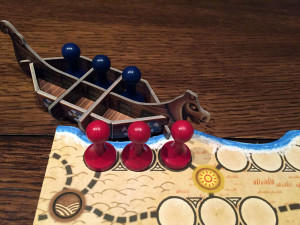
Right out of the gate I knew something wasn’t quite right with this game when I saw how easy it was to force your opponent to skip their first turn. If player one uses all three of their actions to move a raiding party off the boat, they will occupy all the beach spaces. When it comes to the second player’s turn, unless they have a black card in their opening hand, there are about 10 in the 60 card deck, then they will just have to pass their whole turn.
Whether or not this is a good strategy is up for debate. But any time a player can be forced to sit on their hands for a turn, the very first turn, sounds a bit like a broken mechanic.
With regards to the mechanics, the raiding mechanic itself was actually pretty clever, so I did enjoy that. Forcing players to either “roll the dice” and hope to get lucky with their first raid or spend a black card to spy, was a clever design decision. But, frankly, that was about the only enjoyable part of the game.
The boat moves whenever someone plays a black card. That means if players aren’t playing them, the game will eventually stop moving. At one point, we had every bit of treasure off the board and the boat hadn’t moved far enough to bring out a new tile. So what do we do then? We just had to sit around drawing cards until someone got a black card. And sometimes it can take a LONG time to get one of those cards. And at that point you basically have to waste it just to advance the game.. A game should not force you to make bad choices just to be able to keep playing.
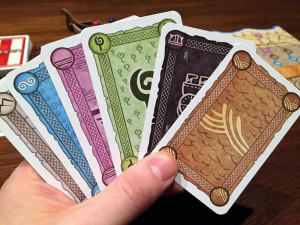
The card drawing mechanic was also a really poor design decision. Players gain 2 cards, plus one more for each pawn in the hinterlands. This can very much have a “rich gets richer” effect because players with pawns in the hinterlands are usually the ones doing the raiding. So not only do you get more cards to play, but these cards also let you raid more often. This can further snowball if your opponent is stuck on the beach because they don’t have the right cards to move off of it. In that case, they just sit there drawing 2 cards a turn, while you are drawing up to 5 a turn and also gaining treasure!
Even with all those bad design decisions, I suppose they could be overlooked if the game was still fun. It’s not. Really, the second time we played it we had to force ourselves to even finish it. I don’t give my wife enough credit for always being willing to test out games with me, if you ever meet her, tell her she’s a saint for me. She took one for the team with Hengist…
But the reason the game isn’t fun is because really all you are doing is playing the cards dealt to you. When you raid, chances are, you just play the cards you have for a path. There is no strategy too it. I have a green and blue card, I guess I’ll take that path because I have no other choice. Consider yourself lucky if you’ll have more than one path option to raid on for you turn. But that’s the majority of the game. Get lucky with a card draw, play the card to raid or move a path. It feels like there is absolutely no strategy in this game.
Expect to get pawns constantly stuck in various places because you don’t have the right color cards to move. And if you happen to lose raiding parties because of a board flip? Better hope you draw one of those elusive black cards to get them back. If my opponent had lost 2 raiding parties, I’d start hoarding black cards knowing what a disadvantage they would be at. You could be drawing 5 cards a turn while your opponent would not only be capped at three, but have much less of a chance to gain treasure.
Final Thoughts:
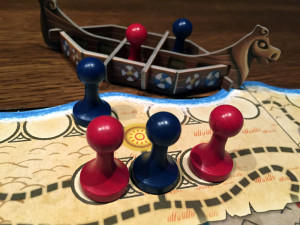
I could go on some more about how terrible this game is, but you get the point. When I said in the components section that my favorite part of this game is the boat, I wasn’t kidding. That’s about the only thing I like about Hengist.
I honestly have no idea what Uwe Rosenberg was thinking releasing this game. From someone to designed a game that’s widely considered a masterpiece (Agricola), I expected better. Now every designer has a clunker. Not every game can be a winner. But Hengist wasn’t just bad, it didn’t even feel fully playtested. The stalling out game, the rich get richer feeling from the card draws, and the opening turn blockage. All that should have come up in even the most early of playtests. I just don’t get it.
It’s a shame that Uwe Rosenberg followed up on his fantastic game Patchwork with this. There is no reason any of you should be buying Hengist. If you want a fantastic two player game from Uwe, go get Patchwork. If you want a highly enjoyable game about vikings raids, pick up a copy of Blood Rage. If you want to take $30 and throw it down the crapper, go buy Hengist.
At least the boat was cool…
If you’d like to pick up a copy of Hengist for some reason, you can get it for about $30.
Final Score: 1.5 Stars – A rare failure from a highly respected game designer. Not sure what Uwe Rosenberg was thinking with this one…
 Hits:
Hits:
• The 3D boat is cool
• Liked the hidden route mechanic
Misses:
• Game can stall out
• Run away leader problem
• Boring game play with low decision-making
• Game feels like it wasn’t fully playtested






















Ugh, that was brutal…
…but 100% accurate, unfortunately.